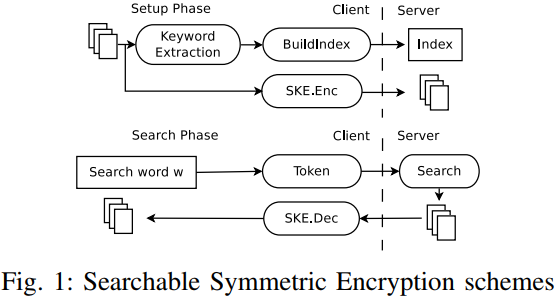Differentially Private Access Patterns for Searchable Symmetric Encryption
| Venue | Category |
|---|---|
| INFOCOM'18 | Differential Privacy |
Differentially Private Access Patterns for Searchable Symmetric Encryption1. SummaryMotivation of this paperAccess-Pattern ObfuscationImplementation and Evaluation2. Strength (Contributions of the paper)3. Weakness (Limitations of the paper)4. Future Works
1. Summary
Motivation of this paper
This paper proposes to protect searchable symmetric encryption (SSE) against access-pattern leakage with a form of access-pattern obfuscation (APO). It is a framework which can built over any given SSE scheme.
A basic workflow of SEE:

This work aims to defend query recovery attacks: The goal of a query recovery attack is to recover the content of a query (i.e., the plaintext keyword) issued by the client to server.
Access-Pattern Obfuscation
Design goal: provide an access-pattern obfuscation mechanism that is compatible with existing SSE schemes.
add false positives and false negatives to the search results. false positive: the server returns some documents that do not match the query (fake documents). false negatives: the server does not return some documents that match the query (violate the correctness of the SEE scheme)
- How to handle correctness issue of false negatives This paper introduce redundancy to the document to collection using erasure codes.
each document multiple shards the collection of all shards is encrypted and outsourced to the remote server.
It argues allowing a probability that some matching documents may not be returned is essential to archive a provable privacy guarantee such differential privacy, and a fairly high recall rate, say 99.99%, can be useful in practice already.
- Setup Phase
- For each document , it extracts its keyword list .
- Applying erasure coding to generate shares of , append the keyword list for each share.
- For each share and its keyword list, adopt the access-pattern obfuscation mechanism
some shares of the matching documents will not be returned in response to a query
- Search Phase
- Given a search keyword , the resulting search token is sent to the server.
- The received shares are decrypted.
- -Private Access-Pattern Obfuscation The goal of this privacy definition is to guarantee that for access patterns that are similar, the obfuscated access patterns generated from them are indistinguishable.
, , obfuscated access pattern is observed with high probability, the adversary cannot tell whether or was the original access pattern.
An access-pattern obfuscation mechanism probabilistically convert an access-pattern vector to another access-pattern vector.
the intuition of -privacy is that similar access patterns generate similar obfuscated access patterns. So from an obfuscated access pattern, it is different to infer its original access pattern.

Implementation and Evaluation
- Security Evaluation
- The baseline IKK attack
the adversary's unawareness of the existence of mitigation methods.
- The improved IKK attack
further assume the adversary knows the existence of its defenses. This is possible when the shards of different original documents are different in size. (This point is very important)
- Performance Evaluation
- Storage and Communication Overhead
- Precision
- Runtime Overhead: access latency
2. Strength (Contributions of the paper)
- It proposes d-privacy for access pattern of general SSE schemes
- It designs a d-private access-pattern obfuscation mechanism which is compatible with existing SSE schemes
- It also implement a prototype of the proposed obfuscation mechanism.
3. Weakness (Limitations of the paper)
4. Future Works
- This paper provides a good insight on how to leverage erasure coding to achieve differential privacy, and this can be used in other scenarios. How to use in secure deduplication?
Mainly used to hide access-pattern